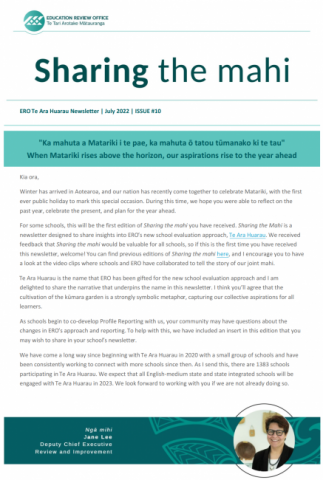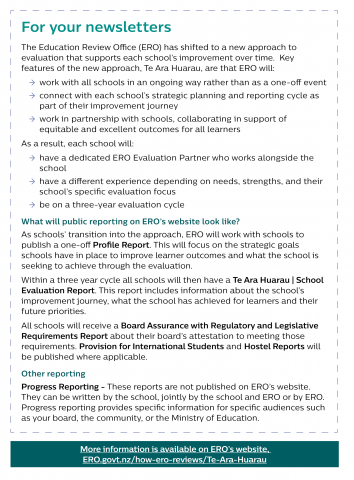
"Ka mahuta a Matariki i te pae, ka mahuta ō tatou tūmanako ki te tau"
When Matariki rises above the horizon, our aspirations rise to the year ahead
Kia ora,
Winter has arrived in Aotearoa, and our nation has recently come together to celebrate Matariki, with the first ever public holiday to mark this special occasion. During this time, we hope you were able to reflect on the past year, celebrate the present, and plan for the year ahead.
For some schools, this will be the first edition of Sharing the mahi you have received. Sharing the Mahi is a newsletter designed to share insights into ERO’s new school evaluation approach, Te Ara Huarau. We received feedback that Sharing the mahi would be valuable for all schools, so if this is the first time you have received this newsletter, welcome! You can find previous editions of Sharing the mahi here, and I encourage you to have a look at the video clips where schools and ERO have collaborated to tell the story of our joint mahi.
Te Ara Huarau is the name that ERO has been gifted for the new school evaluation approach and I am delighted to share the narrative that underpins the name in this newsletter. I think you’ll agree that the cultivation of the kūmara garden is a strongly symbolic metaphor, capturing our collective aspirations for all learners.
As schools begin to co-develop Profile Reporting with us, your community may have questions about the changes in ERO’s approach and reporting. To help with this, we have included an insert in this edition that you may wish to share in your school’s newsletter.
We have come a long way since beginning with Te Ara Huarau in 2020 with a small group of schools and have been consistently working to connect with more schools since then. As I send this, there are 1383 schools participating in Te Ara Huarau. We expect that all English-medium state and state integrated schools will be engaged with Te Ara Huarau in 2023. We look forward to working with you if we are not already doing so.
Ngā mihi
Jane Lee
Deputy Chief Executive
Review and Improvement
Te Ara Huarau: the narrative explained
Hāpaitia te ara tika kia pumau ai te rangatiratanga mō ngā uri whakatipu
Foster the pathway of knowledge to strength, independence and growth for future generations
Māori cultivation is part of the rich cultural legacy that stretches back to the beginnings of time. Māori gardening is underpinned by ancient values, concepts and knowledge.
The cultivation of the kūmara is the metaphor for Te Ara Huarau. This metaphor enriches and deepens our understanding of the optimal conditions needed for the growth of the child in education.
Kūmara cultivation was a highly cooperative undertaking, calling all whānau together, to understand, grow and practise the culture in this work. Whānau are integral to tending the garden. The wisdom of the kaumatua advises on the conditions for cultivation and the tikanga to be followed. Tamariki are engaged and empowered in the process and learning the ways to a fruitful harvest that will benefit all.
Mā tini, mā mano, ka rapa te whai. Many hands make light work, there is strength in unity Kohikohia ngā kākano, whakaritea te pārekereke, kia puāwai ngā hua
Gather the seeds, prepare the seedbed carefully, and you will be gifted with abundance of food
The word “hua” in the whakatauki literally means “fruit” and is also commonly used to mean “outcomes” and can be a description of success for our children.
A pārekereke is a traditional seedbed for growing kūmara seedlings. It is an analogy for the learning environment of children. This environment must be carefully prepared so that it provides well for the growth and development of the child. The importance of planning and preparing this environment cannot be underestimated.
This whakatauki reminds us how important it is to prepare an environment where our tamariki can flourish in terms of our collective responsibility as whānau, as iwi, as educators, communities to ensure that our kids have the most opportunities to blossom and bloom.
Te Ara Huarau recognises the need to understand the local context and the conditions required for a successful and fruitful “harvest” – and working collaboratively for the good of the people.
Nā tō rourou, nā taku rourou, ka ora ai te iwi – With your food basket and my food basket the people will thrive
Northcote Intermediate: cultivating kūmara
Northcote Intermediate students, staff and community members talked with ERO’s Evaluation Partner Anjie Savage about the development of the school’s kūmara garden. The growing of the garden is a collective/collaborative process for the benefit of the school community. Evaluating and monitoring outcomes has led to big plans for extending the kūmara garden. The students involved are enthusiastic about learning from others. As the different groups work together they acknowledge the learning from those who have come before them, the ongoing contribution of local community members and the legacy they themselves are gifting to future cohorts of the school and the community.
School leaders and staff have contextualised the learning experience of cultivating the kūmara garden as a metaphor for other learning. When school leaders learned of the narrative for Te Ara Huarau, they were excited about how it aligns to the way they operate as a school and with their evaluation relationship with ERO.
Talking with your community
This insert provides your school community with information about Te Ara Huarau. Please feel free to share this with your community via your newsletters at any time. Some schools have found it helpful to use when sharing their profile reports with their communities.
